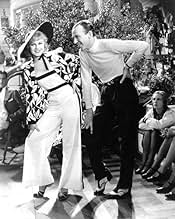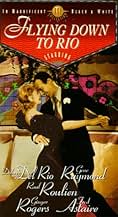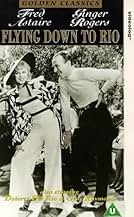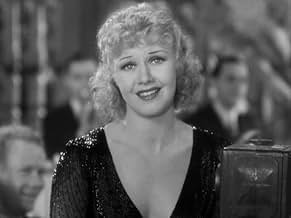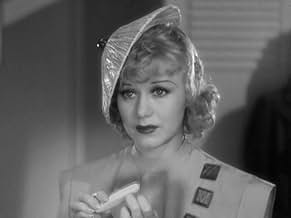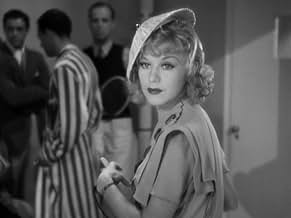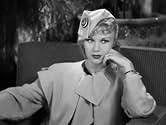NOTE IMDb
6,6/10
4,2 k
MA NOTE
Ajouter une intrigue dans votre langueA bandleader woos a Latin flame who is already engaged to his employer.A bandleader woos a Latin flame who is already engaged to his employer.A bandleader woos a Latin flame who is already engaged to his employer.
- Réalisation
- Scénario
- Casting principal
- Nommé pour 1 Oscar
- 1 victoire et 2 nominations au total
Dolores Del Río
- Belinha De Rezende
- (as Dolores Del Rio)
Luis Alberni
- Rio Casino Manager
- (non crédité)
Bernice Alstock
- Singer
- (non crédité)
Chita Andrews
- Check Girl
- (non crédité)
Avis à la une
FLYING DOWN TO RIO (RKO Radio, 1933), directed by Thornton Freeland, is a musical showcase for Mexican star Dolores Del Rio playing a Brazilian beauty named Belinia De Rezende, Gene Raymond as Roger Bond, a girl chasing orchestra leader, and Raul Roulien as Julio Rubeiro as Belinia's fiancé and Roger's best friend who complicates matters. By the film's conclusion, the ones who "walked off" with the movie are the supporting players of Ginger Rogers as the band vocalist, and Fred Astaire as the accordionist-dancer, in that order, thus, the beginning of a new screen team, and never again in the persona of sassy Honey Hale and semi-sophisticated Fred Ayres. Yet it's amazing that Astaire and Rogers made such a lasting impression at all in this production, considering they play subordinate roles who supply "comedy relief," and have very little opportunity to act or dance together. Even in the famous, "Carioca," number (which was how they became crowned "The King and Queen of the Carioca"), they get to perform only a few dance steps, but the ensemble of other dancers and singers get most of the footage during its 12 minutes. But even without Astaire and Rogers, or either with one of them along with a different partner, FLYING DOWN TO RIO remains an early musical attempt to capture that South American feel and tango rhythm, predating all those cliché musicals MGM or 20th Century-Fox would distribute in the 1940s, with the addition of Technicolor and/or Xavier Cugat and Carmen Miranda, etc. As for the plot elements, it remains similar to the ones used in subsequent Astaire and Rogers films, but this time the situations of strangers meeting followed by a merry mix-up, belongs to its leading players (Del Rio, Raymond and Roulien). The first half of the movie takes place in Miami, Florida, where the plot development amongst the central characters begin, then shifts to Rio De Janiero, the second largest city in Brazil, where the complications continue and are resolved after 89 minutes of screen time. In between all this comes the singing and dancing to help the plot along.
With the music and lyrics by Gus Kahn, Edward Eliscu and Vincent Youmans, the songs include: "Music Makes Me" (sung by Ginger Rogers in the foreground with Fred Astaire, as one of the members of the band, playing the accordion in the background); "The Carioca" (performed by musicians, danced by numerous Brazilians, sung by Movita and Etta Moten, and danced briefly by Astaire and Rogers); "Orchids in the Moonlight" (sung by Raul Roulien to Dolores Del Rio/reprise, danced by Astaire and Del Rio, with one observer saying to another, "Oh, look, Belinha is dancing our tango with an Americano."); "Music Makes Me" (tap dance solo by Astaire); and "Flying Down to Rio" (sung by Fred Astaire/ danced by girls chained to the wings of the flying airplanes).
Other than some advanced camera techniques used in this production, portions of the movie play like a picture postcard advertisement, mainly during its montage sequences where the camera focuses first from an air-view of famous landmarks, then from the ground view of Rio De Janiero, and flipping over to other scenes of the city from people walking the streets to cars driving down the roads before returning to the storyline.
In the supporting cast are Blanche Frederici as Belinda's old-fashioned Aunt (Tia) Elena; Roy D'Arcy, Maurice Black and Armand Kaliz (The Greeks); Franklin Pangborn (Mr. Hammerstein); Luis Alberni (The Rio Casino Manager); and Eric Blore (Mr. Butterbass), making his first of five performances in an Astaire and Rogers musical. He is an asset to every one of them. It's also interesting to note that Raul Roulien remained somewhat obscure after appearing in this, never to become the Cesar Romero-type of Hollywood. As for the few Hollywood movies to feature him in the early 1930s, this is the only one still in circulation today and possibly his best opportunity on screen.
When Gene Raymond was interviewed about FLYING DOWN TO RIO in the documentary on RKO Radio titled "Hollywood, the Golden Years" (as narrated by Ed Asner back in the late 1980s), he mentioned that he thought that FLYING DOWN TO RIO was going to become the "Bomb of Bombs," but much to his surprise when it made its premiere during the Christmas season at Radio City Music Hall, he noticed while being in New York City that there was a long line of people going around the block waiting to go in and see this movie. One cannot be sure that history would repeat itself again in today's society, but FLYING DOWN TO RIO, in spite of whatever is right or wrong it it, is vintage entertainment at best. Only one debit: acrobats flipping and catching one other, and hanging on the swings under the wings of the flying airplane during the "Flying Down to Rio" number. Not realistic, but it got by. And on the historical side, this is where Astaire and Rogers got their start together on screen, thus, becoming the most popular song and dance team of the movies, never to be topped or equaled by anyone. Now that's something to think about!
FLYING DOWN TO RIO, which was formerly shown on American Movie Classics for many years, is currently presented on Turner Classic Movies. It is also available on video cassette and DVD. Recommended highly to fans of the team and/or musicals from this era. (***1/2)
With the music and lyrics by Gus Kahn, Edward Eliscu and Vincent Youmans, the songs include: "Music Makes Me" (sung by Ginger Rogers in the foreground with Fred Astaire, as one of the members of the band, playing the accordion in the background); "The Carioca" (performed by musicians, danced by numerous Brazilians, sung by Movita and Etta Moten, and danced briefly by Astaire and Rogers); "Orchids in the Moonlight" (sung by Raul Roulien to Dolores Del Rio/reprise, danced by Astaire and Del Rio, with one observer saying to another, "Oh, look, Belinha is dancing our tango with an Americano."); "Music Makes Me" (tap dance solo by Astaire); and "Flying Down to Rio" (sung by Fred Astaire/ danced by girls chained to the wings of the flying airplanes).
Other than some advanced camera techniques used in this production, portions of the movie play like a picture postcard advertisement, mainly during its montage sequences where the camera focuses first from an air-view of famous landmarks, then from the ground view of Rio De Janiero, and flipping over to other scenes of the city from people walking the streets to cars driving down the roads before returning to the storyline.
In the supporting cast are Blanche Frederici as Belinda's old-fashioned Aunt (Tia) Elena; Roy D'Arcy, Maurice Black and Armand Kaliz (The Greeks); Franklin Pangborn (Mr. Hammerstein); Luis Alberni (The Rio Casino Manager); and Eric Blore (Mr. Butterbass), making his first of five performances in an Astaire and Rogers musical. He is an asset to every one of them. It's also interesting to note that Raul Roulien remained somewhat obscure after appearing in this, never to become the Cesar Romero-type of Hollywood. As for the few Hollywood movies to feature him in the early 1930s, this is the only one still in circulation today and possibly his best opportunity on screen.
When Gene Raymond was interviewed about FLYING DOWN TO RIO in the documentary on RKO Radio titled "Hollywood, the Golden Years" (as narrated by Ed Asner back in the late 1980s), he mentioned that he thought that FLYING DOWN TO RIO was going to become the "Bomb of Bombs," but much to his surprise when it made its premiere during the Christmas season at Radio City Music Hall, he noticed while being in New York City that there was a long line of people going around the block waiting to go in and see this movie. One cannot be sure that history would repeat itself again in today's society, but FLYING DOWN TO RIO, in spite of whatever is right or wrong it it, is vintage entertainment at best. Only one debit: acrobats flipping and catching one other, and hanging on the swings under the wings of the flying airplane during the "Flying Down to Rio" number. Not realistic, but it got by. And on the historical side, this is where Astaire and Rogers got their start together on screen, thus, becoming the most popular song and dance team of the movies, never to be topped or equaled by anyone. Now that's something to think about!
FLYING DOWN TO RIO, which was formerly shown on American Movie Classics for many years, is currently presented on Turner Classic Movies. It is also available on video cassette and DVD. Recommended highly to fans of the team and/or musicals from this era. (***1/2)
The first pairing of Astaire and Rogers, playing second leads to Dolores DelRio and a slightly strabismic Gene Raymond. What music and what dancing!!! And the scenery of 1933 Rio is worth seeing. The story is slight, the acting is slighter but who cares when Astaire and Rogers take the floor for the Carioca. How silly is the concept of a bunch of girls strapped to the wings of airplanes performing over the hotel? But again, who cares?...it's history on film as the seminal appearance of the most famous dance team in the movies. The supporting players are good but what became of Raul Roulien?.....the rest are familiar to fans of old movies. Love the music,(even Orchids in the Moonlight)and especially the title tune which is rather forgotten now. Step back in time and enjoy this dated, but absolutely wonderful film. You won't be sorry and maybe you will dance the Carioca!!
If you watch "Flying Down to Rio" expecting it to be a Rogers and Astaire film, forget it - but it was their debut as a team, dancing the Carioca.
This is a 1933 movie short on plot and, as is often the case with the early talkies, a little slow in parts due to the pace of the dialogue. It is nevertheless a fun movie, with Astaire doing some wonderful solo dancing and of course, his dance with Ginger, which sent them on their way to movie history.
The stars of the film are Dolores Del Rio and Gene Raymond. After bandleader Raymond meets del Rio in the U. S., he ends up in Rio where he competes for her attentions with her fiancé Julio (Raul Roulien), his best friend.
The plot concerns the opening of a hotel in Rio and its planned takeover by another group. When the opening date is changed, the owner cannot get another performing license, so all seems to be lost.
Thus the number "Flying Down to Rio" with chorus girls doing maneuvers on the wings of flying planes. It's a spectacular part of the film, though in spots you can really see how fake it was. It doesn't really matter - it was early film-making where, without the use of computers, artistry and imagination were needed instead, and much was accomplished.
There are some interesting editing experiments noticeable as well, particularly during a big nightclub scene. It was precode, so some of the numbers are pretty darn steamy.
Dolores del Rio was surely one of the most stunningly beautiful women ever to appear on screen. Growing up, I remember seeing Sunday supplements with articles and photos about her current life - it was a good 30 years after this film - and her beauty remained awesome without the plastic surgery techniques available today. She was a true, fantastic beauty, and this film really showcases it.
This isn't the most wonderful musical you'll ever see but it's important nonetheless: It launched Rogers & Astairs, it's an interesting example of early editing, and it's precode. And if you watch it with the wonder that the depression audiences must have had, you'll enjoy it even more.
This is a 1933 movie short on plot and, as is often the case with the early talkies, a little slow in parts due to the pace of the dialogue. It is nevertheless a fun movie, with Astaire doing some wonderful solo dancing and of course, his dance with Ginger, which sent them on their way to movie history.
The stars of the film are Dolores Del Rio and Gene Raymond. After bandleader Raymond meets del Rio in the U. S., he ends up in Rio where he competes for her attentions with her fiancé Julio (Raul Roulien), his best friend.
The plot concerns the opening of a hotel in Rio and its planned takeover by another group. When the opening date is changed, the owner cannot get another performing license, so all seems to be lost.
Thus the number "Flying Down to Rio" with chorus girls doing maneuvers on the wings of flying planes. It's a spectacular part of the film, though in spots you can really see how fake it was. It doesn't really matter - it was early film-making where, without the use of computers, artistry and imagination were needed instead, and much was accomplished.
There are some interesting editing experiments noticeable as well, particularly during a big nightclub scene. It was precode, so some of the numbers are pretty darn steamy.
Dolores del Rio was surely one of the most stunningly beautiful women ever to appear on screen. Growing up, I remember seeing Sunday supplements with articles and photos about her current life - it was a good 30 years after this film - and her beauty remained awesome without the plastic surgery techniques available today. She was a true, fantastic beauty, and this film really showcases it.
This isn't the most wonderful musical you'll ever see but it's important nonetheless: It launched Rogers & Astairs, it's an interesting example of early editing, and it's precode. And if you watch it with the wonder that the depression audiences must have had, you'll enjoy it even more.
This movie is typical of its time in the 'two guys and a girl' storyline, this time over the alluring Doleres del Rio (scarily, she looked much the same as this as Elvis Presley's mother in 'Flaming Star' years later). Gene Raymond plays the conniving bandleader who chases her from Miami to Rio, with an impromptu island stop en route.
There are some nice touches (the ghostly 'consciences' of Raymond and del Rio for one, the back projection of orchids and palm trees showcasing her thoughts as her local hick boyfriend sings 'Orchids in the Moonlight') but of course the real interest of this movie is for two reasons - one, the clever and inventive acrobatic stuff with the girls tied to aeroplane wings etc over a new nightspot; and two, the first screen teaming of Fred Astaire and Ginger Rogers, who light up the movie with 'The Carioca'. Fred may have been far from a looker but there is no denying his talent and there was certainly ample chemistry with Rogers for the teaming to work. They'd go on to brighter and better things through the 30s, but this film is fun.
There are some nice touches (the ghostly 'consciences' of Raymond and del Rio for one, the back projection of orchids and palm trees showcasing her thoughts as her local hick boyfriend sings 'Orchids in the Moonlight') but of course the real interest of this movie is for two reasons - one, the clever and inventive acrobatic stuff with the girls tied to aeroplane wings etc over a new nightspot; and two, the first screen teaming of Fred Astaire and Ginger Rogers, who light up the movie with 'The Carioca'. Fred may have been far from a looker but there is no denying his talent and there was certainly ample chemistry with Rogers for the teaming to work. They'd go on to brighter and better things through the 30s, but this film is fun.
In Miami, during the presentation of the Yankee Clippers, the wolf band leader and pilot Roger Bond (Gene Raymond) flirts with the guest Belinha de Resende (Dolores Del Rio) and the stringent hotel manager fires them. However, the band is hired for the opening night of the Atlântico Hotel in Rio de Janeiro, and they need to fly to Brazil.
When Roger meets Belinha in the hall of the hotel, he learns that she lost her flight to Rio and he offers a ride for her in his plane. Roger is forced to land in an island and he immediately fixes the mechanical problem in the plane; however, he lies to Belinha and tells that he can not fix the problem just to spend the night alone with her. But Belinha, who is the fiancée of the Brazilian Júlio, resists to his harassment and later she finds another plane to fly to Rio.
Once in Rio, the infatuated Roger meets his friend Júlio without knowing that he is the fiancé of Belinha, and he tells about his love for the woman. When the Yankee Clippers are ready to open the hotel, powerful bankers that are interested to force the bankruptcy of the Atlântico's owner to take the hotel, send the police since he does not have the permit to anticipate the opening day. However, Roger's friend and musician Fred Ayres (Fred Astaire) proposes an airborne show to the guests. Meanwhile, the brokenhearted Roger decides to return to his country and leave Belinha with Júlio.
"Flying Down to Rio" is the debut of the pair Fred and Ginger in minor support roles. The sappy and naive romance has the Mexican Dolores Del Rio performing a Brazilian sassy woman and Gene Raymond in the lead roles. The footages from Rio de Janeiro in the 30's and the airborne show are the best moments of this film. The funniest thing in "Flying Down to Rio" is that there is no Brazilian actor or actress in the cast. My vote is six.
Title (Brazil): "Voando para o Rio" ("Flying to Rio")
When Roger meets Belinha in the hall of the hotel, he learns that she lost her flight to Rio and he offers a ride for her in his plane. Roger is forced to land in an island and he immediately fixes the mechanical problem in the plane; however, he lies to Belinha and tells that he can not fix the problem just to spend the night alone with her. But Belinha, who is the fiancée of the Brazilian Júlio, resists to his harassment and later she finds another plane to fly to Rio.
Once in Rio, the infatuated Roger meets his friend Júlio without knowing that he is the fiancé of Belinha, and he tells about his love for the woman. When the Yankee Clippers are ready to open the hotel, powerful bankers that are interested to force the bankruptcy of the Atlântico's owner to take the hotel, send the police since he does not have the permit to anticipate the opening day. However, Roger's friend and musician Fred Ayres (Fred Astaire) proposes an airborne show to the guests. Meanwhile, the brokenhearted Roger decides to return to his country and leave Belinha with Júlio.
"Flying Down to Rio" is the debut of the pair Fred and Ginger in minor support roles. The sappy and naive romance has the Mexican Dolores Del Rio performing a Brazilian sassy woman and Gene Raymond in the lead roles. The footages from Rio de Janeiro in the 30's and the airborne show are the best moments of this film. The funniest thing in "Flying Down to Rio" is that there is no Brazilian actor or actress in the cast. My vote is six.
Title (Brazil): "Voando para o Rio" ("Flying to Rio")
Le saviez-vous
- AnecdotesStanding outside a bakery shop in Rio, Ginger Rogers asks, "Oh, Freddie, how do you ask for little tarts in Portuguese?" Fred Astaire replies, "Don't heckle me, try the Culbertson System." This pre-Code, double entendre joke would have been funny to Depression-era audiences, for whom bridge was a common pastime. Ely Culbertson was a champion bridge player and worldwide celebrity, who had won several international tournaments by developing a rather aggressive bidding system. He was also notorious for his sexual exploits. His 1940 autobiography was banned in many countries. In the 1930s, the word "tart" was equivalent to "slut" or "whore". Also, in the opening inspection of hotel staff, the boss sees a maid whose shoe heels are oddly beveled and says he will not tolerate that sort of thing. A "round-heeled woman" was 1930s slang for a prostitute, a woman who could tilt easily from standing to being on her back.
- GaffesFrom the height they were flying, most of the "dance" routines of the young women on the plane wings would not be visible to people on the ground.
While true, this observation is not a Goof. The purpose of the event likely was more for advertising or Newsreel value, or even simply "bragging rights".
- Citations
Belinha's Friend: What have these South Americans got below the equator that we haven't?
- ConnexionsFeatured in Hollywood and the Stars: The Fabulous Musicals (1963)
- Bandes originalesMusic Makes Me
(1933) (uncredited)
Music by Vincent Youmans
Lyrics by Gus Kahn and Edward Eliscu
Performed by Ginger Rogers
Meilleurs choix
Connectez-vous pour évaluer et suivre la liste de favoris afin de recevoir des recommandations personnalisées
- How long is Flying Down to Rio?Alimenté par Alexa
Détails
Box-office
- Budget
- 462 000 $US (estimé)
- Durée1 heure 29 minutes
- Couleur
- Rapport de forme
- 1.37 : 1
Contribuer à cette page
Suggérer une modification ou ajouter du contenu manquant




